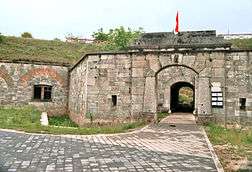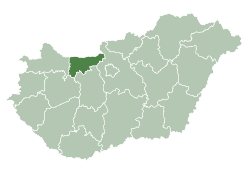Komárom
| Komárom Brigetio (in ancient Latin) Comaromium (in medieval Latin) Komorn (in German) Komárno (in Slovak) | ||
|---|---|---|
| Town | ||
 | ||
| ||
 Komárom Location of Komárom in Hungary | ||
| Coordinates: 47°44′25″N 18°7′28″E / 47.74028°N 18.12444°ECoordinates: 47°44′25″N 18°7′28″E / 47.74028°N 18.12444°E | ||
| Country | Hungary | |
| Region | Central Transdanubia | |
| County | Komárom-Esztergom | |
| Subregion | Komáromi | |
| Rank | City | |
| Area[1] | ||
| • Total | 70.19 km2 (27.10 sq mi) | |
| Population (2017)[2] | ||
| • Total | 18,805[3] | |
| Time zone | UTC+1 (CET) | |
| • Summer (DST) | UTC+2 (CEST) | |
| Postal code | 2900 | |
| Area code | +36 34 | |
| KSH code | 05449[4] | |
| Website |
www | |
Komárom (Slovak: Komárno, German: Komorn) is a city in Hungary on the south bank of the Danube in Komárom-Esztergom county. Komárno, Slovakia, is on the northern bank. Komárom was formerly a separate village called Újszőny. In 1892 Komárom and Újszőny were connected with an iron bridge and in 1896 the two towns were united under the name city of Komárom. The fortress played an important role in the Hungarian Revolution of 1848 and many contemporary English sources refer to it as the Fortress of Comorn[5]
History
Following the Hungarian conquest of the Carpathian Basin at the turn of the 9th and 10th centuries, Prince Árpád gave Komárom and the Komárom county vicinity to tribal chieftain Ketel. Ketel was the first known ancestor of the famous Koppán (genus) clan. At the beginning of the 12th century, this tribe founded the town's Benedictine Monastery in honor of the Blessed Virgin, mentioned in 1222 by the name of Monostorium de Koppán. The Turks destroyed much of the monastery and its surroundings in 1529, and the area was thus depopulated. Later references refer to it as the Pioneer Monastery (Pusztamonostor). Presently, it is called Koppánymonostor (Koppán's Monastery) in honor of its founding family. Roman ruins (including a stone mile marker and watchtowers) still stand today. [6]
The town was heavily damaged in the 1763 Komárom earthquake.
Between 1850 and 1871 the Fort Monostor (Monostori Erőd) was built nearby.
In 1918 Komárom was split by the newly created border of Czechoslovakia. In 1920 Hungary was forced to sign the Treaty of Trianon recognizing the new imposed borders including the border with Czecho-Slovakia. The loss of its territory created a sizable Hungarian minority in Slovakia. The Slovak part is today Komárno, Slovakia. In 1938 the entire city was returned to Hungary, its Regent, Admiral Horthy receiving a tumultuous welcome from the citizens as he crossed the old bridge and entered the formerly dismembered part.[7] At the end of World War II the city was again divided between Hungary and Czecho-Slovakia.
After World War II the occupying Soviets built the country's biggest ammunition storage in the Fortress of Monostor. Thousands of wagons of ammunition were forwarded from this strictly guarded area. One of a series of forts, the Monostor is today open to the public as a museum.
Komárom and Komárno are connected by two bridges: The older iron bridge, and a newer lifting bridge. A third bridge is planned, with the vast majority of funding coming from the European Union's Connecting Europe Facility.[8]
The two towns used to be a border crossing between Czecho-Slovakia (today Slovakia) and Hungary, until both countries became part of the Schengen Area, resulting in all immigration and customs checks being lifted on December 12, 2007.
| Significant minority groups | |
| Nationality | Population (2011) |
|---|---|
| 163 | |
| 125 | |
| 30 | |
| 25 | |
| 12 | |
Notable people
- Franz Heckenast (1889–1939), Austrian artillery officer and opponent of Nazism
- Cardinal Leopold Karl von Kollonitsch (1631–1707), Catholic prelate
- Franz Lehár (1870–1948), Austro-Hungarian composer
- Theodor Körner, Austrian President
- Mór Jókai (1825-1904), writer
- Hans Selye (1907–1982), Hungarian-Austrian-Canadian endocrinologist
- Péter Szijjártó (born 1978), Hungarian Minister of Foreign Affairs and Trade[9]
- Endre Komaromi-katz, painter [10]
Twin towns — sister cities
Komárom is twinned with:
See also
Notes and references
- ↑ Komárom at the Hungarian Central Statistical Office (Hungarian).
- ↑ Komárom at the Hungarian Central Statistical Office (Hungarian). 2017
- ↑ Komárom, KSH
- ↑ Komárom at the Hungarian Central Statistical Office (Hungarian).
- ↑ e.g. Ripley, George; Anderson, Charles (1860). The New American Cyclopaedia. D. Appleton. p. 362.
- ↑ "Koppánymonostor (in Hungarian)". city of Komárom, Hungary. Retrieved April 26, 2018.
- ↑ https://www.youtube.com/watch?v=hs1NjePbPho
- ↑ http://www.worldhighways.com/sections/general/news/new-danube-river-bridge-to-get-100-million-finance-from-eu/
- ↑ "Hon. Péter Szijjártó - Minister of Foreign Affairs and Trade of Hungary". The 2016 Global 500 Who Is Who Book of Records (Global Lifetime Achievement Award Winners). Public Opinions International. Archived from the original on 25 October 2016.
- ↑ "Komáromi-katz Endre". Hungarian Art Portal (Nemzeti Kulturális Alap). Archived from the original on 22 December 2015.
External links
| Wikimedia Commons has media related to Komárom. |
- Official website in Hungarian, English, German and Slovak
- Aerial photography: Komárom
- Komárom on wiki.utikonyvem.hu
- "The Battle at Comorn in Hungary on 11th July 1849" - painting by Albrecht Adam, 1855


